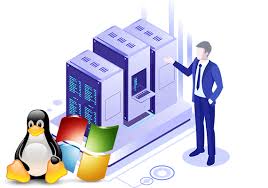The Linux operating system is widely popular today all over the world. It’s a type of open-source software that anybody may use for free. This operating system was first introduced in the early 1990s and has grown in popularity since the turn of the century. Linux is the operating system of choice for supercomputers and servers (both dedicated and virtual).
The operating system is made up of many fundamental programs that allow a computer to interface with other computers and receive instructions from them. Control memory utilization and run other applications while reading and writing data to hard discs, cassettes, and printers. The kernel is the most crucial component of the operating system. The kernel of a GNU/Linux system is Linux. Other programs, many of which were produced by the GNU project, make up the remainder of the system. We prefer the phrase “GNU / Linux” to refer to systems that many people wrongly name “Linux” since a single Linux kernel is not the full operating system. This operating system has recently grown in popularity among home and personal computers, as well as in business settings.
Components Of The Linux System
There are three primary components to the Linux operating system:
- The kernel, the most important component of this operating system. It is in charge of all forms of activities and is made up of a huge number of various types of modules that allow basic equipment to interface with it. This is also what allows apps to utilize computer resources in a coordinated manner.
- System Library, the Linux system library is a function or application that allows system utilities to access the kernel and its features. It is not essential to have access to the kernel module code in order to use the system library to implement most of the operating system’s operations.
- System Utility, Programs are necessary and useful in order to complete various degrees of specific tasks.
1. Ubuntu
Ubuntu is an operating system built on the GNU/Linux foundation. Canonical is the firm that created this operating system. This operating system is now widely used, with around 22 million users globally. When it comes to web servers, this Linux distribution is the most popular.
This system’s upgrades are published every 5-6 months, while security updates are released every 8-9 months.
2. Kubuntu
The KDE graphical environment is used by this operating system. Until version 12.04, this distribution was supported and developed. Updates are issued every six months for this project, which is part of the Ubuntu project. On December 10, 2004, this operating system was released for the first time in Spain. On April 8, 2005, the first version was released. “Hoary Hedgehog” is the name of the 5.04 version.
3. Mint
Mint is an Ubuntu and Debian-based Linux system. The major goals of this distribution are to give consumers a basic and easy-to-use interface. Clement Lefebvre is the creator of this distribution.
A menu called “GNOME” is included in the operating system’s structure. Contextual search is embedded into this menu, allowing you to install new packages and programs from the repositories without having to leave the search term.
4. Deepin
Deepin is a Linux distribution that includes the Deepin music player, the DMovie video player, and the Deepin Store application center. There are roughly 30 language panel options available in this release.
This distribution is relatively user-friendly, especially for those unfamiliar with the Linux platform, however, it is noted for its poor loading speed and significant memory usage in sleep mode.
5. PC Linux OS
This Linux distribution allows you to install the operating system directly to your hard disc. The Linux-based top distribution kits include this operating system, which was established on October 24, 2003. The APT package management application is used to promote PCLinuxOS. It also comes with a support system for major multimedia formats as well as a wide number of embedded drivers.
This system’s most recent upgrade was issued in June 2016. This was the 2018-06 edition. Since 2003, the version has been upgraded 30 times, allowing it to improve its capabilities and become one of the most popular Linux-based systems.
6. Linux Lite
This is a Linux distro made for hardware that is no longer supported. The Linux operating system team felt it was essential and vital to include this technology for older and more productive computer types.
The developers’ ambition is intriguing: to offer Linux Lite to Windows users! The “gateway operating system” is the only name given to it by its creators. The name “Amethyst” was given to this system in 2012. The most recent version (as of today) is version 4.4, which is based on Ubuntu 18.04 and was published on March 31, 2019.
The following are some useful tools:
- Lite Welcome
- Lite Sounds
- Notify of Lite Updates
- Lite Network Shares
7. Zorin OS
This distribution was first released in 2008, and it now has around 4,000 users. This is a distribution kit whose user interface was created to be as similar to Windows Explorer as feasible. It comes in both premium and free editions, with the following minimum system requirements:
- x86 CPU with a clock speed of 1 GHz
- Hard disc space of 5 GB
- System memory: 512MB (RAM)
- A video card with a resolution of 640 x 480 pixels
In 2009, the first version was published. Many participants noted that it allows them to quickly get information on the appearance of desktops and browsers.


